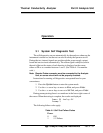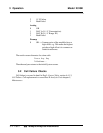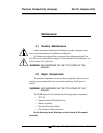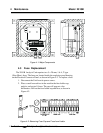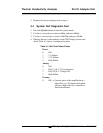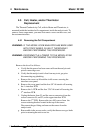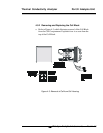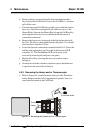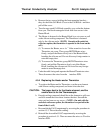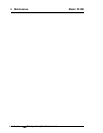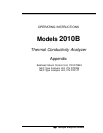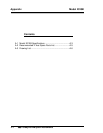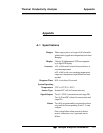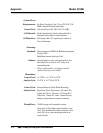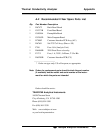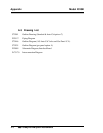
Thermal Conductivity Analyzer Part II: Analysis Unit
Teledyne Analytical Instruments Part II: 4-7
b. Remove the two screws holding the front mounting bracket—
they also hold the Cell Block Cover to the Cell Block—and then
pull off the cover.
c. Turn the uncovered Cell Block assembly over so that the bottom
faces you. The black rectangular block with four screws is the
Heater Block.
d. The Heater is fastened to the Heater Block by a set screw as well
as the silicone sealing compound. The Thermistor is fastened
only by the silicone sealer. (NOTE: On units with sealed air
reference option, the thermistor is epoxied to the front on the
cell.)
(1) To remove the Heater, use a
1
/16 ″ Allen wrench to loosen the
Thermistor set screw. Then, grasp BOTH Heater wires
firmly, and pull the Heater slowly out of the Heater Block,
breaking the silicone seal. Do not allow any foreign matter to
enter the empty duct.
(2) To remove the Thermistor, grasp BOTH Thermistor wires
firmly, and pull the Thermistor slowly out of the Heater
Block, breaking the silicone seal. Do not allow any foreign
matter to enter the empty duct.
e. Undo the cable lacing and separate the Heater/Thermistor wires.
Then, disconnect the wires from the interface PCB.
4.5.4 Replacing the Heater and/or Thermister
a. To replace the Heater and/or Thermister, coat the new element
with silicone sealing compound, and insert it into the duct.
CAUTION: The larger duct is for the Heater element, and the
smaller duct is for the Thermocouple.
b. Enough sealing compound should be on the element to spill over
and seal around the wire where it enters the duct. Smooth the
outer seal and remove any excess. (NOTE: On unit with the
sealed air reference option, the thermistor is expoxied to the
front of the t/c cell.)
c. Reassemble the Cell Compartment by reversing the procedure in
section 4.5.3. Then relace the cabling.
d. Reinstall the Assembled Cell Compartment by reversing the
procedure in section 4.5.1. Then reconnect the wires to J2 on the
interface PCB.



